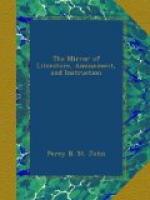[Footnote 4: It is singular, but almost true to an axiom, that objects capable of exciting disgust in their reality, confer delight in their pictorial representation; the interior of some wretched hovel, a sty and its inmates, and a boorish revel, will exemplify this. Our pleasure in that case arises perhaps not from the objects represented, but from the truth of the representation. I know not that this paradox has ever been solved, and therefore with diffidence offer, that we are rather pleased with the artist than his subject.]
Essay 2nd treats of travelling, as far as it regards the picturesque, which is to be sought in natural, and sometimes artificial, objects; these will constantly present themselves to the observer under all the varieties of light and shadow, and the different combinations of colour, form, and accompaniment, sometimes producing whole landscapes, but more frequently only beautiful parts of scenery. The curious and fantastic forms of nature are not subjects for the pencil,—and the draughtsman will endeavour to depict animate as well as inanimate objects. The utility and amusement of travelling, are also considered in this essay, and hints thrown out for the improvement of barren and disagreeable country, by the observation of lights and shadows, tints of the season, distances, &c., with a recommendation to supply, if possible, every hiatus of nature, by the imagination of all that is needed to render her perfectly picturesque. (An ingenious idea; but, alas! mountains will not always rise in a marsh, forests wave over a sterile heath, nor lakes and rivers adorn a wheat-field. This essay, however, is worthy the perusal of travellers even, who never touched a pencil.)
Essay 3rd treats of sketching from nature from whence are deduced the following
Rules.
1. Every landscape should have a leading subject; a rule too much neglected even by superior artists.
2. Get the object, or subject you design to copy, into the best point of view.
3. Landscape consists of three general parts:—fore-ground, middle or second-ground, and distance; in sketching foreground, it is a good rule to have some part of it higher than the rest of the picture. (Vide Rule the 7th.)
4. Mark the principal parts, (or points) of your landscape on paper, that you may more readily ascertain the relative distances and situations of the others.




